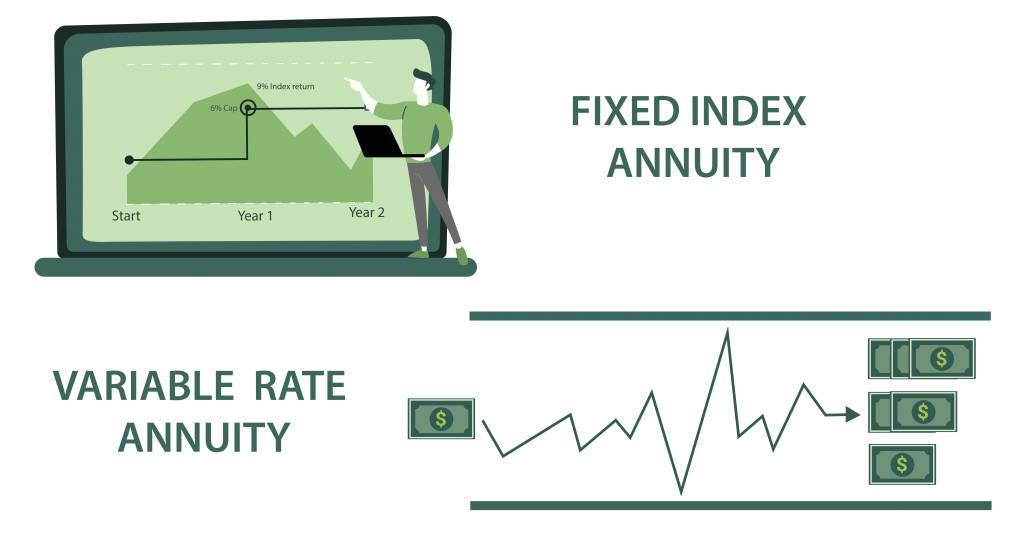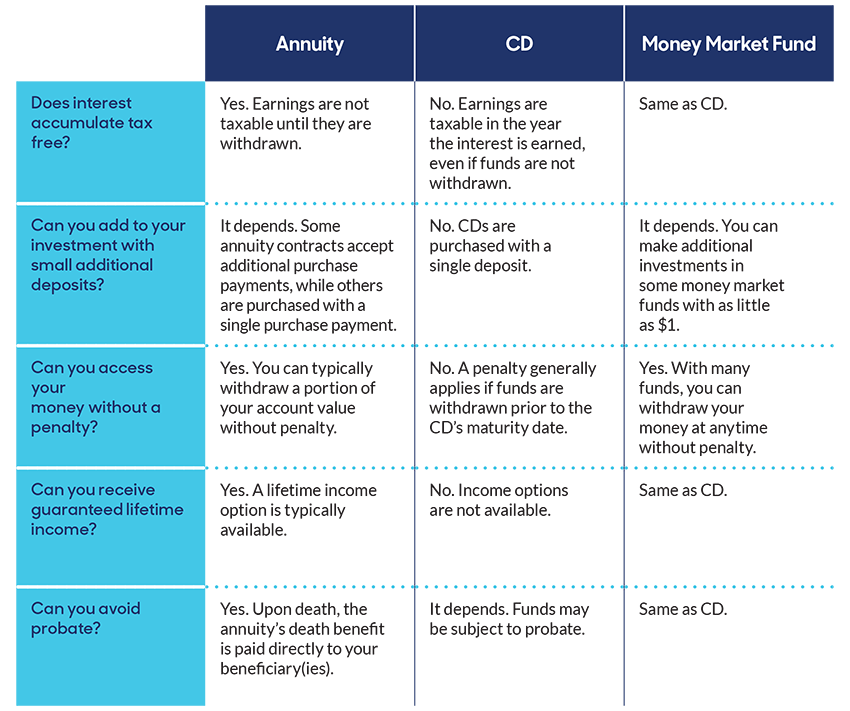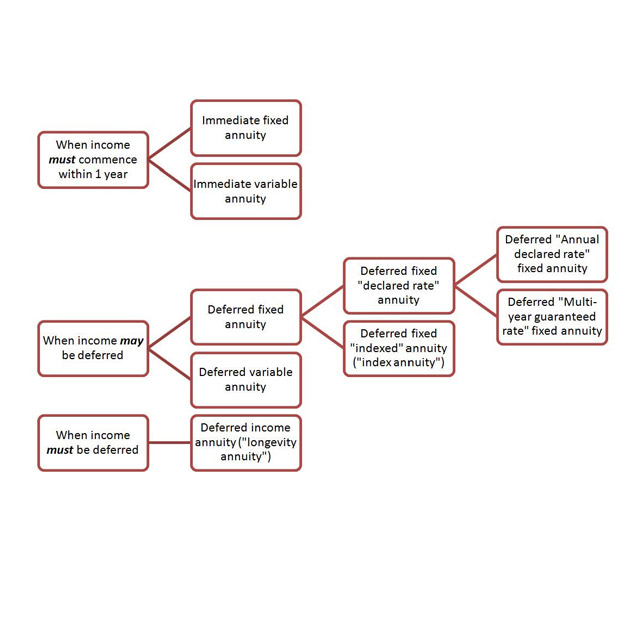All Categories
Featured
Table of Contents
There are 3 types of annuities: dealt with, variable and indexed. With a repaired annuity, the insurance business guarantees both the price of return (the interest price) and the payout to the financier.
With a deferred fixed annuity, the insurance coverage firm agrees to pay you no much less than a defined price of interest as your account is growing. With a prompt fixed annuityor when you "annuitize" your postponed annuityyou get a predetermined fixed amount of cash, generally on a month-to-month basis (similar to a pension plan).
While a variable annuity has the advantage of tax-deferred growth, its annual costs are most likely to be a lot greater than the costs of a normal common fund. And, unlike a repaired annuity, variable annuities don't offer any type of warranty that you'll make a return on your financial investment. Instead, there's a threat that you could actually shed cash.
Exploring the Basics of Retirement Options Key Insights on Your Financial Future Defining the Right Financial Strategy Advantages and Disadvantages of Fixed Annuity Vs Variable Annuity Why Choosing the Right Financial Strategy Is a Smart Choice Tax Benefits Of Fixed Vs Variable Annuities: Explained in Detail Key Differences Between Different Financial Strategies Understanding the Rewards of Variable Annuity Vs Fixed Indexed Annuity Who Should Consider Variable Annuities Vs Fixed Annuities? Tips for Choosing Variable Vs Fixed Annuities FAQs About Indexed Annuity Vs Fixed Annuity Common Mistakes to Avoid When Choosing Variable Annuities Vs Fixed Annuities Financial Planning Simplified: Understanding Fixed Annuity Vs Equity-linked Variable Annuity A Beginner’s Guide to Annuities Fixed Vs Variable A Closer Look at Variable Vs Fixed Annuities
Because of the intricacy of variable annuities, they're a leading source of investor problems to FINRA. Before getting a variable annuity, thoroughly read the annuity's program, and ask the person selling the annuity to describe every one of the item's functions, cyclists, costs and restrictions. You ought to also know how your broker is being compensated, consisting of whether they're obtaining a commission and, if so, just how much.
Indexed annuities are intricate economic tools that have characteristics of both taken care of and variable annuities. Indexed annuities usually provide a minimum guaranteed passion price incorporated with a rate of interest connected to a market index. Many indexed annuities are tied to broad, well-known indexes like the S&P 500 Index. Some usage other indexes, including those that stand for various other segments of the market.
Recognizing the functions of an indexed annuity can be confusing. There are a number of indexing approaches firms make use of to determine gains and, due to the variety and intricacy of the techniques used to credit interest, it's hard to contrast one indexed annuity to one more. Indexed annuities are normally categorized as one of the complying with two kinds: EIAs use an assured minimum rate of interest (commonly at least 87.5 percent of the premium paid at 1 to 3 percent passion), as well as an additional rate of interest rate tied to the efficiency of one or more market index.

With variable annuities, you can spend in a selection of securities consisting of supply and bond funds. Supply market efficiency identifies the annuity's value and the return you will certainly obtain from the money you spend.
Comfortable with fluctuations in the supply market and desire your financial investments to keep speed with inflation over an extended period of time. Youthful and want to prepare economically for retired life by gaining the gains in the stock or bond market over the long-term.
As you're constructing up your retirement savings, there are several methods to stretch your money. can be especially valuable cost savings devices because they guarantee a revenue quantity for either a set time period or for the remainder of your life. Taken care of and variable annuities are 2 options that provide tax-deferred growth on your contributionsthough they do it in different means.
Analyzing Retirement Income Fixed Vs Variable Annuity A Closer Look at Deferred Annuity Vs Variable Annuity Breaking Down the Basics of Immediate Fixed Annuity Vs Variable Annuity Advantages and Disadvantages of Different Retirement Plans Why Choosing the Right Financial Strategy Can Impact Your Future How to Compare Different Investment Plans: Explained in Detail Key Differences Between Different Financial Strategies Understanding the Rewards of Indexed Annuity Vs Fixed Annuity Who Should Consider Strategic Financial Planning? Tips for Choosing the Best Investment Strategy FAQs About Fixed Vs Variable Annuity Pros And Cons Common Mistakes to Avoid When Choosing a Financial Strategy Financial Planning Simplified: Understanding Fixed Index Annuity Vs Variable Annuity A Beginner’s Guide to Fixed Index Annuity Vs Variable Annuity A Closer Look at Fixed Income Annuity Vs Variable Annuity
variable annuity or both as you outline out your retired life income plan. A supplies a guaranteed rates of interest. It's considered a conservative product, offering a small incomes that are not tied to market efficiency. Your agreement value will increase due to the accrual of assured interest incomes, indicating it won't decline if the market experiences losses.
A consists of bought the securities market. Your variable annuity's investment performance will influence the dimension of your nest egg. It may guarantee you'll receive a collection of payments that start when you retire and can last the remainder of your life, given you annuitize (begin taking repayments). When you begin taking annuity settlements, they will certainly rely on the annuity worth back then.
Market losses likely will cause smaller sized payments. Any rate of interest or various other gains in either type of agreement are protected from current-year taxation; your tax obligation obligation will come when withdrawals start. Let's consider the core attributes of these annuities so you can determine just how one or both might fit with your overall retirement approach.

A fixed annuity's value will certainly not decrease because of market lossesit's regular and steady. On the various other hand, variable annuity values will fluctuate with the efficiency of the subaccounts you choose as the markets increase and drop. Profits on your fixed annuity will highly rely on its contracted price when purchased.
On the other hand, payment on a repaired annuity purchased when rates of interest are reduced are more probable to pay incomes at a reduced price. If the rates of interest is ensured for the length of the contract, revenues will certainly stay constant no matter the markets or price task. A set price does not imply that taken care of annuities are risk-free.
While you can't arrive on a fixed price with a variable annuity, you can choose to purchase conservative or hostile funds tailored to your danger degree. Extra conventional financial investment options, such as short-term mutual fund, can assist lower volatility in your account. Given that repaired annuities use an established rate, reliant upon existing passion prices, they don't supply that very same flexibility.
Understanding Fixed Index Annuity Vs Variable Annuities A Comprehensive Guide to Investment Choices What Is the Best Retirement Option? Advantages and Disadvantages of Fixed Index Annuity Vs Variable Annuities Why Fixed Income Annuity Vs Variable Growth Annuity Is a Smart Choice How to Compare Different Investment Plans: Simplified Key Differences Between Annuities Fixed Vs Variable Understanding the Risks of Long-Term Investments Who Should Consider Strategic Financial Planning? Tips for Choosing Retirement Income Fixed Vs Variable Annuity FAQs About Fixed Income Annuity Vs Variable Growth Annuity Common Mistakes to Avoid When Choosing a Financial Strategy Financial Planning Simplified: Understanding Fixed Vs Variable Annuity A Beginner’s Guide to Smart Investment Decisions A Closer Look at Immediate Fixed Annuity Vs Variable Annuity

Of the its guaranteed development from built up passion repayments stands apart. Fixed rates of interest offer small growth for their assured revenues. You possibly can make more lengthy term by taking added threat with a variable annuity, yet you can also shed cash. While taken care of annuity contracts prevent market risk, their compromise is less development capacity.
Spending your variable annuity in equity funds will certainly offer even more possible for gains. The charges connected with variable annuities may be greater than for various other annuities. Investment options, survivor benefit, and optional advantage assurances that may expand your possessions, additionally include expense. It's necessary to examine features and linked fees to guarantee that you're not investing greater than you need to.
The insurance coverage business might impose abandonment fees, and the Internal revenue service may impose a very early withdrawal tax obligation penalty. They begin at a specific percentage and then decline over time.
Annuity revenues are subject to a 10% very early withdrawal tax charge if taken before you get to age 59 unless an exception applies. This is imposed by the IRS and relates to all annuities. Both fixed and variable annuities offer choices for annuitizing your equilibrium and turning it right into a guaranteed stream of lifetime revenue.
Understanding Financial Strategies Everything You Need to Know About Fixed Vs Variable Annuities Defining Fixed Indexed Annuity Vs Market-variable Annuity Advantages and Disadvantages of Different Retirement Plans Why Choosing the Right Financial Strategy Matters for Retirement Planning How to Compare Different Investment Plans: Simplified Key Differences Between Different Financial Strategies Understanding the Rewards of Long-Term Investments Who Should Consider Strategic Financial Planning? Tips for Choosing the Best Investment Strategy FAQs About Fixed Vs Variable Annuity Common Mistakes to Avoid When Choosing Retirement Income Fixed Vs Variable Annuity Financial Planning Simplified: Understanding Your Options A Beginner’s Guide to Variable Vs Fixed Annuities A Closer Look at Variable Annuities Vs Fixed Annuities
You might decide to make use of both dealt with and variable annuities. But if you're choosing one over the various other, the distinctions matter: A may be a far better option than a variable annuity if you have a much more conventional threat tolerance and you seek foreseeable rate of interest and principal defense. A may be a much better option if you have a higher risk tolerance and desire the potential for lasting market-based development.
There are different types of annuities that are designed to serve different purposes. A set annuity assurances settlement of a collection amount for the term of the contract.
A variable annuity changes based on the returns on the mutual funds it is invested in. Its value can go up or down. An immediate annuity starts paying as soon as the customer makes a lump-sum payment to the insurer. A deferred annuity begins repayments on a future day established by the customer.
Annuities' returns can be either fixed or variable. With a dealt with annuity, the insurance policy company guarantees the purchaser a details settlement at some future day.
Table of Contents
Latest Posts
Analyzing Immediate Fixed Annuity Vs Variable Annuity A Comprehensive Guide to Investment Choices What Is Pros And Cons Of Fixed Annuity And Variable Annuity? Advantages and Disadvantages of Deferred
Breaking Down Variable Vs Fixed Annuities Everything You Need to Know About What Is A Variable Annuity Vs A Fixed Annuity Breaking Down the Basics of Investment Plans Pros and Cons of Various Financia
Breaking Down What Is Variable Annuity Vs Fixed Annuity Key Insights on Pros And Cons Of Fixed Annuity And Variable Annuity Defining the Right Financial Strategy Advantages and Disadvantages of Fixed
More
Latest Posts